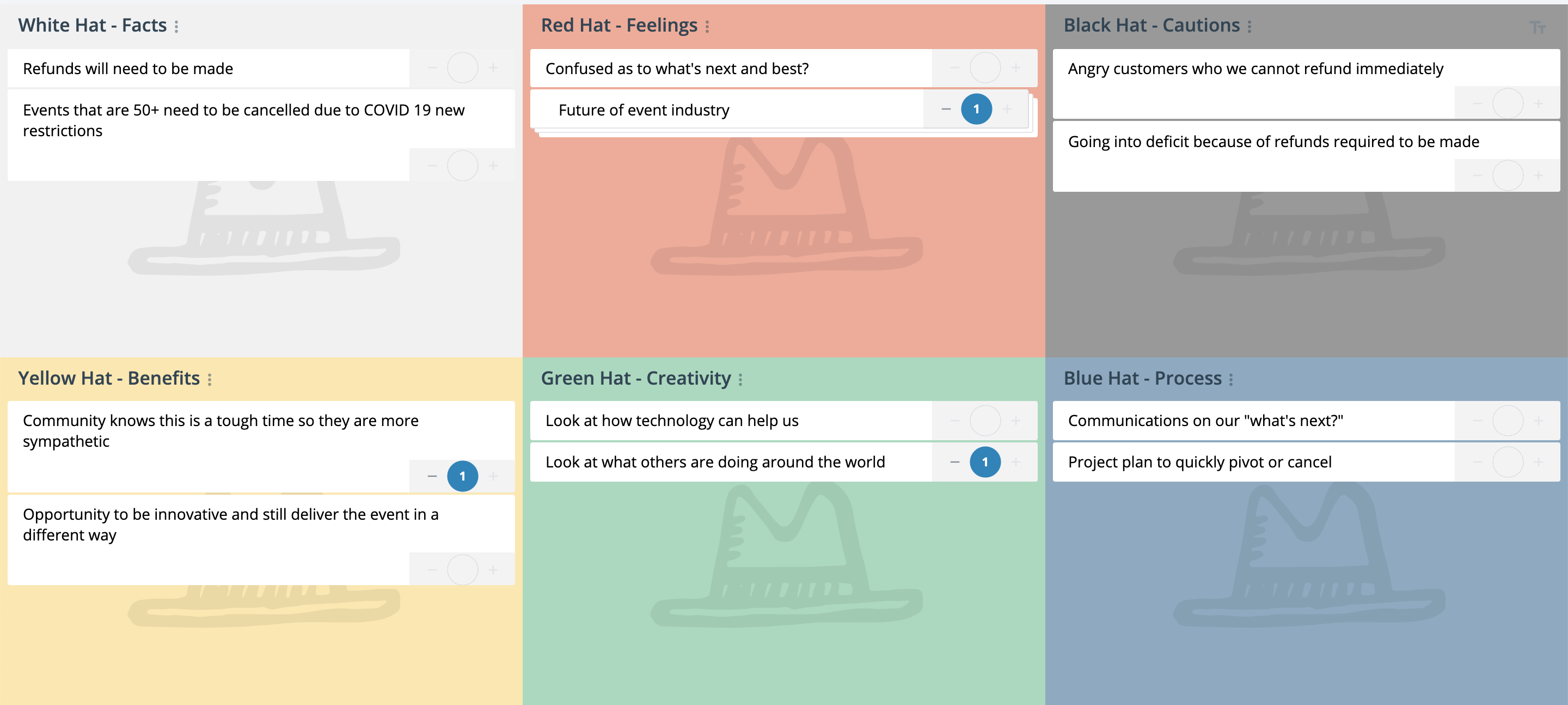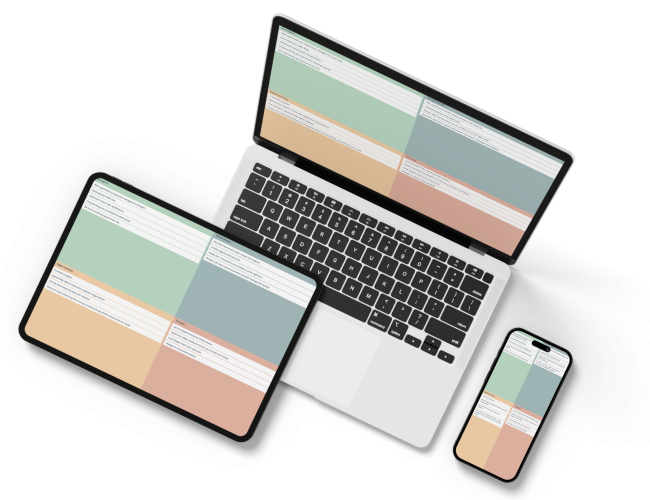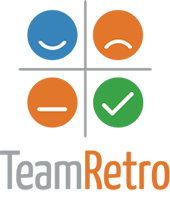
What is the Six Thinking Hats?
The Six Thinking Hats is a role-playing model developed by Edward de Bono in 1986. Each hat represents a different lens or perspective on a particular issue and is an insightful activity that prevents narrow thinking.
It serves as a team-based problem solving and brainstorming technique that can be used to explore problems through various perspectives in order to uncover options that might otherwise be overlooked.
The basic premise behind the Six Thinking Hats is that most people think and reason in a specific way based on their personality type. This means that a more emotional person may generate ideas differently than a more analytical person, and vice-versa. Similarly a pessimist will approach a situation very differently than an optimist.
An example of the benefit of running the thinking hats techniques is therefore to encourage different perspectives to be shared, seen and discussed as part of the decision making process.
The six types of “Thinking Hats” are:
- White Hat: Similar to the calm and pure emotions associated with the colour white, this type of thinking focuses on analytical, objective thinking, with an emphasis on facts and feasibility.
- Red Hat: We often associate the colour red with anger and heat and hence this represents emotional thinking, subjective feelings, perception, and opinion.
- Black Hat: The colour black has been stereotypically linked with doom and gloom and so this forms a type of thinking that is critical, skeptical, focused on risks, and identifying problems.
- Yellow Hat: Often symbolising sunshine and happiness, the yellow hat is about thinking optimistic, speculative, best-case scenarios.
- Blue Hat: Blue being the colour of the sky and high above creates a sense of structured thinking, high-level overview of the situation, the big picture.
- Green Hat: Associated with the colour of trees and nature, the green hat is about creative, associative thinking, new ideas, brainstorming, out-of-the-box.
Related Templates
Tips for Using Six Thinking Hats Technique
- Encourage each person to contribute to each of the perspectives. Avoid putting people into categories – Everyone can and should use all the hats.
- One or more hats can be used at any point during a discussion process.They are used as a convenience for directing and switching the thinking process as needed. (E.g. “Let’s have some black hat thinking…”)
- Simple sequences of two or three hats may be used together for a particular purpose, for example:
- The yellow hat followed by the black hat may be used to assess an idea.
- The black hat followed by the green hat may be used to improve a design.
- Six Thinking Hats is excellent at eliciting different perspectives, but there is less guidance on how to resolve conflicting views among the different hats. Sometimes a group will naturally move together toward one resolution during the discussion. If not, another framework might be needed to resolve the discourse.
Use the Six Thinking Hats for Better Meetings
Six Thinking Hats is a powerful technique for decision making that includes different points of view.
The process and methodology allows emotion and skepticism to be brought into what might normally be a purely rational process, and it opens up the opportunity for creativity within decision making.
Decisions made using the Six Thinking Hats technique can be more resilient and based on a holistic perspective, allowing you to avoid pitfalls and gaps before you have committed to a decision.
When Should I Use the Six Thinking Hats Technique?
Use the Six Thinking Hats model to help with:
- Running better and more structured meetings especially if there tends to only be a single view at every meeting.
- Making better decisions by having a more holistic and wide ranging view of the problem.
- Approaching problems from various angles of facts, emotions and creativity.
- Inspiring idea generation as an ice-breaker activity by having different people play different roles.
- More collaboration during brainstorming and decision making with assigned roles including facilitator responsibilities.
Six Thinking Hats Template Example
Imagine if you are facilitating a meeting to introduce a new product or service to the market. In doing so, you might ask people to wear different hats, or to navigate between the hats around this goal.
White Hat
“What are the facts that we know?”
– Our survey last month indicated a 5% preference of the green product by women aged 25 – 45.
– Return rates from sales has fallen by over 50% since the introduction of the new delivery packaging.
– There are new delivery routes available via Company Logistics.
Yellow Hat
“Why should we be optimistic?”
– The new product could increase our revenue diversification stream and increase our family of products.
– We can start receiving better feedback and testimonials from our customers.
– The impact from damage from delivery will meet our service standards.
Red Hat
“What are your gut reactions?”
– The green colour inspires a sustainable look and is very appealing. This is even a great shade.
– The impact on the reduced return rates could mean additional resources.
– How do the new delivery routes impact our delivery times? I would certainly be interested in learning more about it.
Green Hat
“How can we create opportunities?”
– A green range could be expanded to a different colour range set or be symbolic.
– Creating multiple channels will allow us to establish new partnerships and partners.
– Speeding up quality and reliability of delivery could allow us to bundle exisiting products.
Black Hat
“What risks should we keep in mind?”
– Is a 5% preference sufficient for us to make a single colour product? What happens if preferences change.
– What is the cost of maintaining the packaging quality and sustainability?
– The new delivery routes may not have been proven as reliable yet or may increase our costs.
Blue Hat
“What systems or processes will be needed?”
– Let’s go around the room and discuss the colour options based.
– How has the reduced return rates impacted our warehousing department?
– Would there be any other changes to our workflow with a new delivery partner and will it change our logistics technology?
How to Use the Six Thinking Hats to Run Better Meetings
Six Thinking Hats is a powerful technique for looking at decision-making from different points of view. By introducing a structured parallel thinking process, it helps people to be more focused and mindfully involved in a discussion.

Brainstorm
Start brainstorming through each of the different hats.

Group
Review the responses for common themes that can be grouped.

Vote
Have people voted on the topics that they would like to discuss the most.

Share
Share the results and facilitate the discussion towards a decision.
Facilitate the conversation (wearing the blue hat).
As an inspiration, check the following example of how to use Six Thinking Hats sequentially to resolve a problem with alternative solutions:
- White Hat: Present the facts of the problem
- Green Hat: Generate ideas on how the problem can be solved
- Yellow Hat: Evaluate the ideas by listing their benefits
- Black Hat: Evaluate the ideas by listing their drawbacks
- Red Hat: Get everybody’s gut feelings about the alternatives
- Blue Hat: Summarise the discussion and agree on the conclusions
Tip
You may decide which sequence of hat use fits best for your purpose. In general, it is recommended that each hat is worn at some point however, there are some sensible sequences too.
Once you have completed the brainstorm for each thinking hat, review the responses and look for common themes which can be grouped into one.
This step is more time consuming if the brainstorming was performed individually – or completed at different times and locations. Using a software tool like GroupMap to group ideas can significantly reduce the time and effort required in this step – and result in a better outcome.
Now that there are clear themes, encourage your participants to vote on the top three ideas they would like to discuss further.
You can facilitate this by advising participants to vote based on:
- the level of importance to action or implement;
- aspects that they would like to discuss or explore further;
- areas that they have questions on and require clarification.
Combining individual voting into an overall score is much easier and faster if you use an online tool like GroupMap, especially if you can vote on ideas individually and independently.
With the votes tallied, you can now better facilitate the discussion in the meeting and help the group come to a more considered and educated decision.
Sharing the outcomes of the Six Thinking Hats process ideas and comments with the wider group of stakeholders as well as the team is essential to getting buy in!
The results of your Six Thinking Hats should allow for the next steps of:
- Communication to relevant stakeholders.
- Further analysis using other business tools such as a SWOT Analysis for each of your top voted discussions.
- Product and design thinking activities, including customer personas.

Save Effort, Time and Money with GroupMap
GroupMap offers more than just an online digital whiteboard—it’s innovative platform is designed to enhance the quality of your team’s decisions. With features that prevent bias and make facilitation seamless, GroupMap ensures no single voice dominates and ensures productive, inclusive conversations.
Its intuitive interface is easy for anyone to use, and its scalable design supports small teams and large groups whether they are face to face or around the globe. Customisable templates and workflows keep discussions focused on objectives, helping you drive actionable outcomes each and every time.
Create your first map and invite people in to start sharing their thoughts NOW.
Experience the power of GroupMap with our FREE 14 day trial.
Your free trial gives you access to all of our features, no credit card required.
